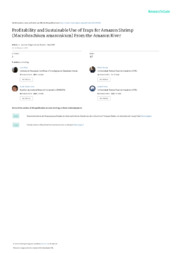Profitability and sustainable use of traps for amazon shrimp (Macrobrachium amazonicum) from the Amazon River.
Profitability and sustainable use of traps for amazon shrimp (Macrobrachium amazonicum) from the Amazon River.
Author(s): MELO, O. de A.; SILVA, L. M. A. da; SOUSA, P. H. C.; SILVA, S. L. F.; LIMA, J. de F.; SANTOS JÚNIOR, L. C. F. dos; FERNANDES, L. G.; SILVA, K. C. de A.; CINTRA, I. H. A.
Summary: The objective of this study was to evaluate the profitability, productivity and selectivity of traps used for the capture of freshwater prawn using different spacings between the laths. This study was developed in the estuary of the Amazon River near Santana island, Amapá, Brazil. Collections were conducted using traps called "matapi", which are cylindrical shrimp traps made with wooden slats or laths, with funnel shaped entrances at both sides, and the spacings between the laths ranged between 1 to 10mm in 1mm increments. Each trap was covered with a net called a "matapi", or trap cover. The length of carapace in centimeters and the weight in grams were measured for all specimens. The shrimp were categorized into small, medium, and large size classes. Selectivity curves were used to determine selectivity for the dif ferent lath spacings. Traps with lath spacing below 7mm should be considered as being predatory because they allow for the capture of small individuals, with more than 50% of these being captured using spacings from 1 to 5mm. Despite the fact that spacings between 8 and 10mm captured lower quantities of shrimp, this enabled the capture of larger specimens with a similar total biomass yield, and this spacing is considered to be the most ecologically and economically viable. In order to minimize the capture of young shrimp without drastically affecting economic yield, it is suggested that shrimp trap lath spacings be above 6mm.
Publication year: 2020
Types of publication: Journal article
Unit: Embrapa Amapá
Keywords: Camarão, Harvesting, Regional shrimp, Small scale fishery, Traps
Observation
Some of Embrapa's publications are published as ePub files. To read them, use or download one of the following free software options to your computer or mobile device. Android: Google Play Books; IOS: iBooks; Windows and Linux: Calibre.
Access other publications
Access the Agricultural Research Database (BDPA) to consult Embrapa's full library collection and records.
Visit Embrapa Bookstore to purchase books and other publications sold by Embrapa.

